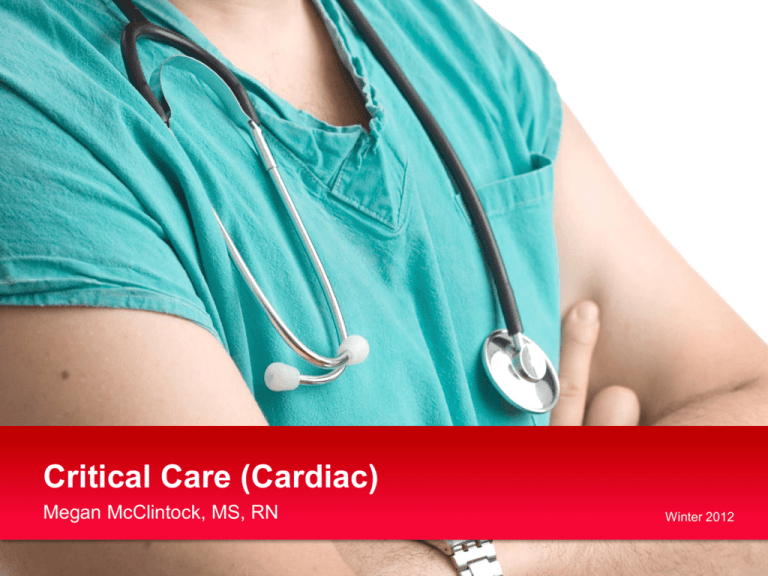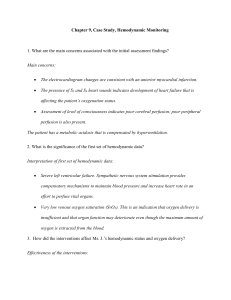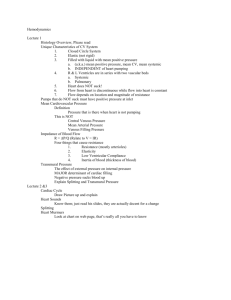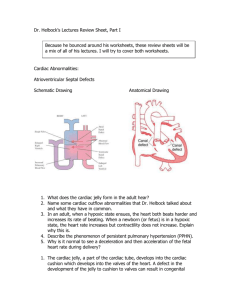Critical Care (Cardiac)
advertisement

Critical Care (Cardiac) Megan McClintock, MS, RN Winter 2012 CCUs or ICUs • RRTs – rapid response teams – Pts exhibit subtle changes 6-8 hrs before a cardiac and/or respiratory arrest – Critical care nurse, RT, MD or APN • PCUs – Transition between ICU and general care • Critically ill patient – Physiologically unstable – At risk for serious complications – Requires intensive and complicated nursing support Common Problems of ICU Patients • Venous thromboembolism d/t immobility • Skin problems d/t immobility • Nutritional deficiencies d/t hypermetabolic or catabolic states – Start enteral or parenteral nutrition early • Anxiety d/t threat to physical health, foreign environment, pain, sleeplessness, immobilization, loss of control, impaired communication – – – – Work closely with pts, families, caregivers Encourage caregivers to bring in personal items and photographs Judiciously use antianxiety drugs (ie. Ativan) Judiciously use massage, guided imagery Common Problems of ICU Patients • Pain d/t medical conditions, immobilization, invasive monitoring devices and procedures – Continuous IV sedation (ie. Propofal [Diprivan]) and an analgesic (ie. Fentanyl [Sublimaze]) but include a daily “sedation vacation” • Impaired Communication d/t use of sedative or paralyzing drugs, ET tube – – – – – – Always explain what is happening to the patient Use picture boards, notepads, computer keyboards Look directly at the patient Use hand gestures when appropriate Use an interpreter with non-English speaking patients Provide comforting touch Common Problems of ICU Patients • Sensory-Perceptual Problems d/t delirium – Assess for delirium with the Confusion Assessment Method for ICU and the Intensive Care Delirium Screening Checklist – Address physiologic factors – Use clocks and calendars to help orient the pt – Encourage presence of a caregiver – May need haloperidol (Haldol) • Sensory-Perceptual Problems d/t sensory overload – – – – – Be cautious with conversations Mute phones Set alarms appropriate to the pt’s condition Limit overhead paging Limit any unnecessary noise Common Problems of ICU Patients • Sleep Problems d/t noise, anxiety, pain, frequent monitoring, treatment procedures – – – – – – – Structure the environment to promote the sleep-wake cycle Cluster activities Schedule rest periods Dim lights at nighttime, open curtains during daytime Limit noise Provide comfort measures (ie. Back rubs) Use benzodiazepines (ie. Temazepam [Restoril]) or zolpidem (Ambien) Caregivers • • • • • • • • Give them guidance and support Actively listen Provide them with opportunity to participate in decision making Involve durable power of attorney for health care if pt is incapable of making decisions Give convenient access to the pt Prepare caregivers for the ICU and the pt’s appearance Provide for the option of family presence during invasive procedures and CPR Be culturally aware especially in regards to death and dying Hemodynamic Monitoring • Measurement of pressure, flow, and oxygenation within the cardiovascular system – Invasive (internally placed) – Noninvasive (externally placed) – Includes: • • • • • • Systemic and pulmonary arterial pressures CVP – central venous pressure PAWP – pulmonary artery wedge pressure CO/CI – cardiac output/cardiac index SV/SVI – stroke volume/stroke volume index Oxygen saturation – Integrating and trending all of this data together provides a picture of the pt’s hemodynamic status – Very important to be technically accurate to prevent unnecessary or inappropriate treatment Hemodynamic Terminology • Cardiac Output (CO) and Cardiac Index (CI) – Volume of blood (in liters) pumped by the heart in 1 minute, cardiac index is adjusted for BSA and is a more precise measure of efficiency of the pumping action of the heart – Increased with high circulating volume – Decreased with low circulating volume or decrease in strength of ventricular contraction – CO normal 4-8, CI normal 2.5-4 • Stroke Volume (SV) and Stroke Volume Index (SVI) – Volume of blood (in mL) ejected with each heartbeat, determined by preload, afterload and contractility, SVI is adjusted for BSA – Increased with volume overload, inotropy, hyperthermia, meds (ie. Digitalis, dopamine, dobutamine) – Decreased with impaired cardiac contractility, valve dysfunction, CHF, beta blockers, MI – SV normal 50-100, SVI normal 25-45 Hemodynamic Terminology • Systemic Vascular Resistance (SVR) – Opposition encountered by left ventricle – Increased with vasoconstrictors, low volume – Decreased with vasodilators, morphine, nitrates, high CO2 • Pulmonary Vascular Resistance (PVR) – Opposition encountered by right ventricle – Increased with pulmonary hypertension, hypoxia – Decreased with meds (ie calcium channel blockers, aminophylline, isoproterenol, oxygen) • Preload, afterload, and contractility determine SV which then determines CO and BP Hemodynamic Terminology • Preload – – – – Volume in the ventricle at the end of diastole Combination of pulmonary blood filling the atria and stretching Regulated by variability in intravascular volume PAWP will show us left ventricular preload (AKA left ventricular end-diastolic pressure) – CVP will show us right ventricular preload (AKA right ventricular end-diastolic pressure) – Increased with fluid administration – Decreased with diuretics and vasodilation Hemodynamic Terminology • Afterload – Forces opposing ventricular ejection including systemic arterial pressure, resistance from the aortic valve, mass/density of the blood – Resistance the heart has to overcome to send blood to the aorta affected by vasoactivity and blood viscosity – SVR shows left ventricular afterload – PVR shows right ventricular afterload – When afterload is increased, cardiac output is decreased – To decrease afterload give vasodilators Hemodynamic Terminology • Contractility – Strength of contraction – If the cardiac output changes but everything else stays the same, then the problem is with contractility – When it is increased it increases stroke volume and oxygen demand – Increased with meds (ie. Epinephrine, norepinephrine, isoproteronol, dopamine, dobutamine, digitalis) – Decreased with heart failure, alcohol, calcium channel blockers, beta blockers, acidosis • Frank Starling’s Law – the greater the preload, the greater the myocardial stretch, and the greater the oxygen need which increases CO and SV Arterial Lines • Purpose • Allen’s test • Position transducer level with the heart, then zero to negate the pressure applied by the flush • Look for a normal waveform – dicrotic notch (systolic pressure) should be after QRS on EKG • Correlate with manual BP CVP Monitoring • Purpose – to tell us about the right ventricle • Placed while in Trendelberg position, CVC is threaded so that the tip rests in the superior vena cava • Can give IV fluids and draw venous blood • High point of waveform should correlate with R of ECG PA Catheter • • • • Purpose – to tell us about the left ventricle and measure CO Often called Swan-Ganz catheter Proximal port is for CVP and fluids Distal port is for PA and PCWP with balloon inflation (balloon floats the catheter into a pulmonary artery branch vessel – wedge) • Thermistor – continuous temperature readings to calculate CO (inject 5-10 mL cold fluid as exhalation begins, take the average of 3 times) • Very important that the waveform has not changed or the catheter may be displaced CVP or Right Atrial Pressure Normal is 2-6 • Approximates right ventricular end diastolic pressure (blood in the right atrium) • Tells us about right ventricular function and general fluid status • Increased with overhydration, increased venous return or right-sided heart failure, straining • Decreased with hypovolemia, decreased venous return MAP – Mean Arterial Pressure Normal is 70-100 • Reflects changes in the relationship between CO and SVR and reflects arterial pressure in vessels perfusing the organs • Increased with increased cardiac workload • Decreased with decreased blood flow to the organs • Can make it increase by administering fluids PAP – Pulmonary Artery Pressure Normal is 20-30 (systolic), 8-12 (diastolic), 25 (mean) • BP in the pulmonary artery • Increased with left to right cardiac shunt, PA hypertension, COPD, emphysema, PE, pulmonary edema, left ventricular failure PCWP or PAWP – Pulmonary Capillary Wedge Pressure • Normal 4-12 • Approximates left ventricular end diastolic pressure • Increased with left ventricular failure, mitral valve problems, cardiac insufficiency, cardiac compression Right Ventricular Pressure Normal is 0-5 (diastolic), 20-30 (systolic) • Indicates right ventricular function and fluid status • Increased with pulmonary hypertension, right ventricular failure, CHF Circulatory Assist Devices • Used to decrease cardiac work and improve organ perfusion – Ventricles require support while recovering from acute injury – Pt must be stabilized before surgical repair – Heart has failed and pt is awaiting cardiac transplant • Intraaortic Balloon Pump (IABP) – most commonly used – Balloon is placed in the descending thoracic aorta above the renal arteries – Balloon fills with helium at start of diastole and deflates before systole (triggered by the ECG), counterpulsation – inflates opposite to ventricular contraction – Inflates with every heartbeat • Ventricular Assist Device (VAD) – Allows more mobility than the IABP – Placed internally or externally – Shunts blood from left atrium or ventricle to the device and then to the aorta







